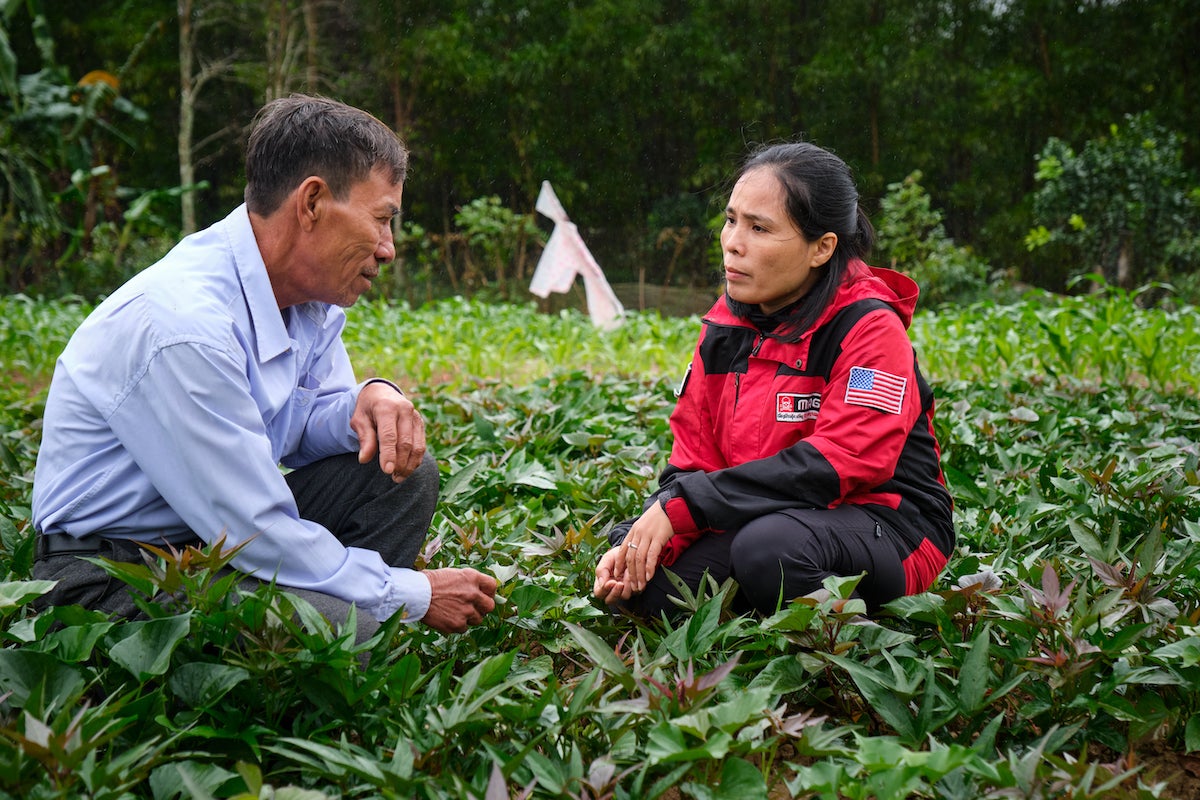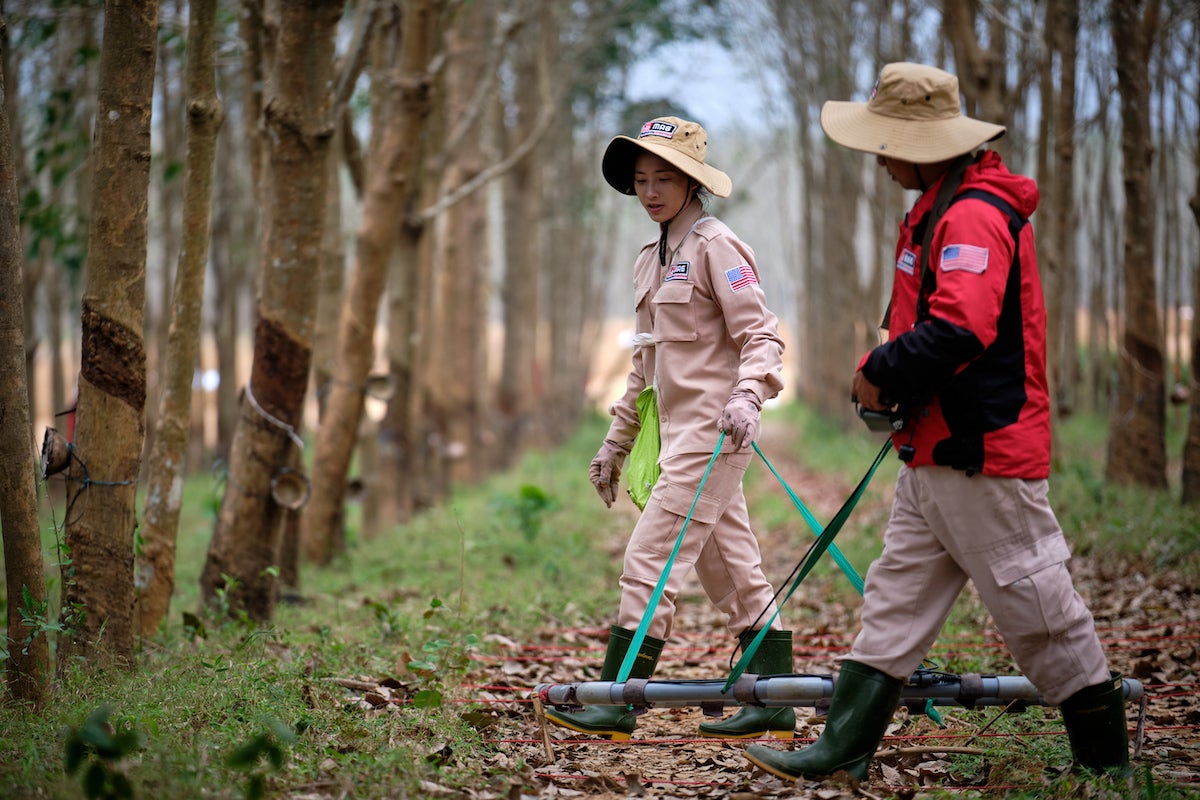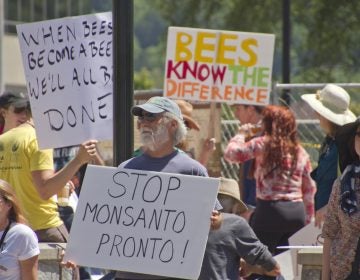How declassified historic satellite images could help clear unexploded bombs in Vietnam 50 years later
The U.S. dropped millions of tons of bombs on Southeast Asia during the Vietnam War. Some remain, and could still explode.
This story is from The Pulse, a weekly health and science podcast. Subscribe on Apple Podcasts, Spotify, or wherever you get your podcasts.
Find our full episode marking 50 years since the end of the Vietnam War here.
When Hoàng Thi Mai Chi grew up in Quảng Bình province in Vietnam, her parents and grandparents warned her to be on the lookout for unexploded bombs. She saw a lot of them, including some bombs right in front of her house.
One day, she was out in the field when two young brothers, 4 and 8 years old, found a bomb and brought it to their home. She ran over when she heard the explosion, and the two boys died in front of their parents.
“I still can feel the sadness that the family has to face during the loss of their children,” she said.
The U.S. military dropped millions of tons of bombs on Vietnam, Laos, and Cambodia for almost a decade during the Vietnam War. That’s far more than it dropped during World War II or the Korean War. Not all the bombs exploded — the Vietnamese government estimates hundreds of thousands of tons of them remain in the landscape, and that they cover more than 15 percent of the country.
These bombs could still explode if someone picks them up, handles them, or hits them accidentally with farming equipment. Tens of thousands of people have died from what is called unexploded ordnance in the decades since the Vietnam War ended, even after years of people working to find and remove them.
Living among the bombs
Hoàng is now a community assessment manager with the Mines Advisory Group, an international nonprofit organization, working to clear these explosives.
She said people have no choice but to farm and work in areas where the bombs are.

“If we don’t do it, then we don’t have anything … to get income, or anywhere to live,” Hoàng said.

Just last year, a large, several-hundred-pound bomb was found in the city where she lives.
These bombs are not just dangerous; they have also held back the local economy, according to research from Erin Lin, a political scientist who teaches at The Ohio State University.
Lin studied the famously fertile soil in the part of Cambodia that borders Vietnam, where the soil is soft, retains water very well, and is so rich that farmers can grow multiple crops of rice a year without having to rely on irrigation. She found that it was more likely for bombs not to explode on fertile soil, because these bombs were designed to explode on impact, but the U.S. military tested them in the rocky terrain of Nevada and New Mexico.
“When a lot of these cluster bombs and the general purpose bombs actually hit some of these really fertile areas of Cambodia, they were essentially the areas that are the least likely for these bombs to go off,” Lin said. “So you have farmers that are essentially in the most fertile areas who were the most afraid to farm because these are the most dangerous areas.”

When Lin did her research in Cambodia, she recalled seeing what she thought were rocks, but were actually rocks with some cluster bombs mixed in. She could not tell the difference.
Some of these bombs are visible, but others remain buried, so finding them can be a challenge. Staff like Hoàng who clear unexploded ordnance rely on people reporting bomb sightings, as well as historic records to find out where the U.S. military targeted.
But Vietnam has some unique challenges, said explosives disposal consultant Seán Moorhouse, who has worked around the world clearing bombs and mines.
Subscribe to The Pulse
“It’s very strange that almost 50 years after the end of the Vietnam War, or as the Vietnamese call it, the American War, we still don’t know the full extent of the contamination that exists in Vietnam.”
He said one obstacle is accessing some of the remote locations that the U.S. military bombed.
“You can be driving for many, many hours from the nearest hardened road surface up … mountain tracks to get to these locations.”
Detecting remaining bombs
Data scientist Philipp Barthelme had an idea to find these bombs faster, using historic satellite images. He was furloughed during the COVID-19 pandemic, and looking for ideas, when he found that the U.S. military and CIA had recently declassified satellite images of Vietnam from the 1970s and 80s. He looked at a picture of Quảng Tri Province, next to where Hoàng lives.
When he zoomed into the image, he saw “thousands and thousands of bomb craters spread around everywhere.”
The U.S. military carpet bombed large areas during the war, so Barthelme thought that if he could match these pictures of old bomb craters to current locations, that could lead people to where unexploded bombs might still be buried today.
He zoomed in to look at bomb craters, and found that they look different depending on what kind of land the bomb fell on, and what kind of bomb. A bomb that falls in a forest makes a different kind of crater than one that falls in a rice paddy.
He worked on this as a PhD project at the University of Edinburgh, in collaboration with the Conflict and Environment Observatory, a U.K. charity that studies the environmental harm of war and conflict.
Barthelme trained a machine learning computer program to go through old satellite images and find the different bomb craters, which would have taken months if he had done it by hand. He recently published his research, and hopes it can help people on the ground find these bombs faster.
“The … technical part of detecting the bomb craters is really the more straightforward part,” he said. “Then it’s about collaborating with some of these NGOs in trying to understand how that could be integrated in their operations and also trying to understand, for example, using existing clearance data that they have in what it shows and what it doesn’t show.”
There are limitations to his method. For instance, satellite images can show craters from large bombs, but it is harder to find smaller cluster bombs this way. The research is interesting, but the main problem in the provinces where Mines Advisory Group works is cluster bombs, said Sarah Goring, the organization’s country director in Vietnam.
There is still decades of work remaining before Vietnam and Cambodia can be bomb free, said Moorhouse, the explosives disposal consultant, adding that it would need an “unimaginable” increase in capacity and funding.
For years, the U.S. government has taken the lead in funding the work of finding and clearing unexploded bombs in southeast Asia. But that recently stopped for more than a month, when the second Trump administration paused all funding to other countries. The U.S. has since continued funding this work, for the time being. A State Department spokesperson said they are reviewing all foreign assistance to “ensure they are aligned with our interests and make America more safe, more secure and more prosperous.”
Moorhouse said that while other countries like Japan and South Korea also help pay for bomb removal, the recent pause in U.S. funding was a big shock.
“There’s always a question of: Does America have a moral obligation to fund the clearance as it actually put the ordinance there in the first place? That’s been a big driver of U.S. funding so far. Whether that continues in the future, obviously, I can’t say, but any reduction in funding would be disastrous for Vietnam.”
Hoàng now has two children of her own.
“We never forget what happened in the past. Even my kids now … are curious about the war and what was going on. However, we have to move on,” she said. “We coordinate and work with different countries, not just America, to build Vietnam and to make peace happen in more countries in the world.”
WHYY is your source for fact-based, in-depth journalism and information. As a nonprofit organization, we rely on financial support from readers like you. Please give today.







